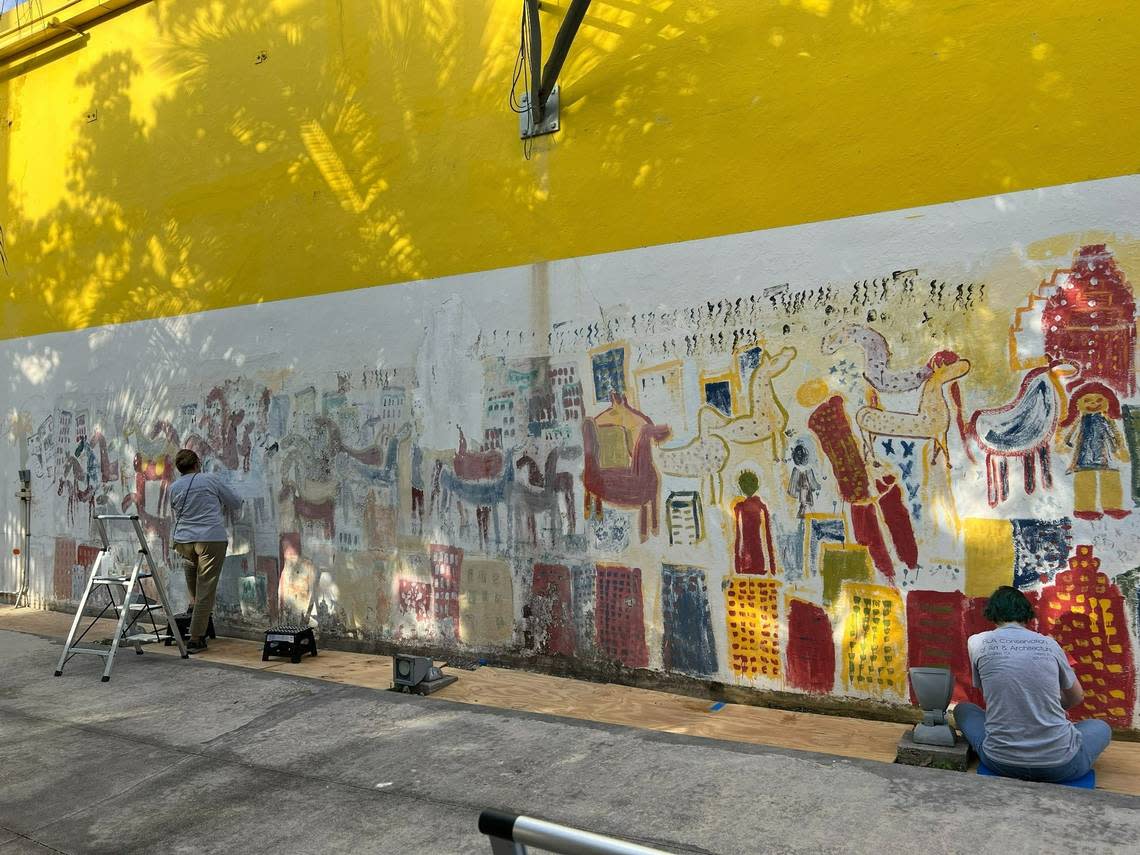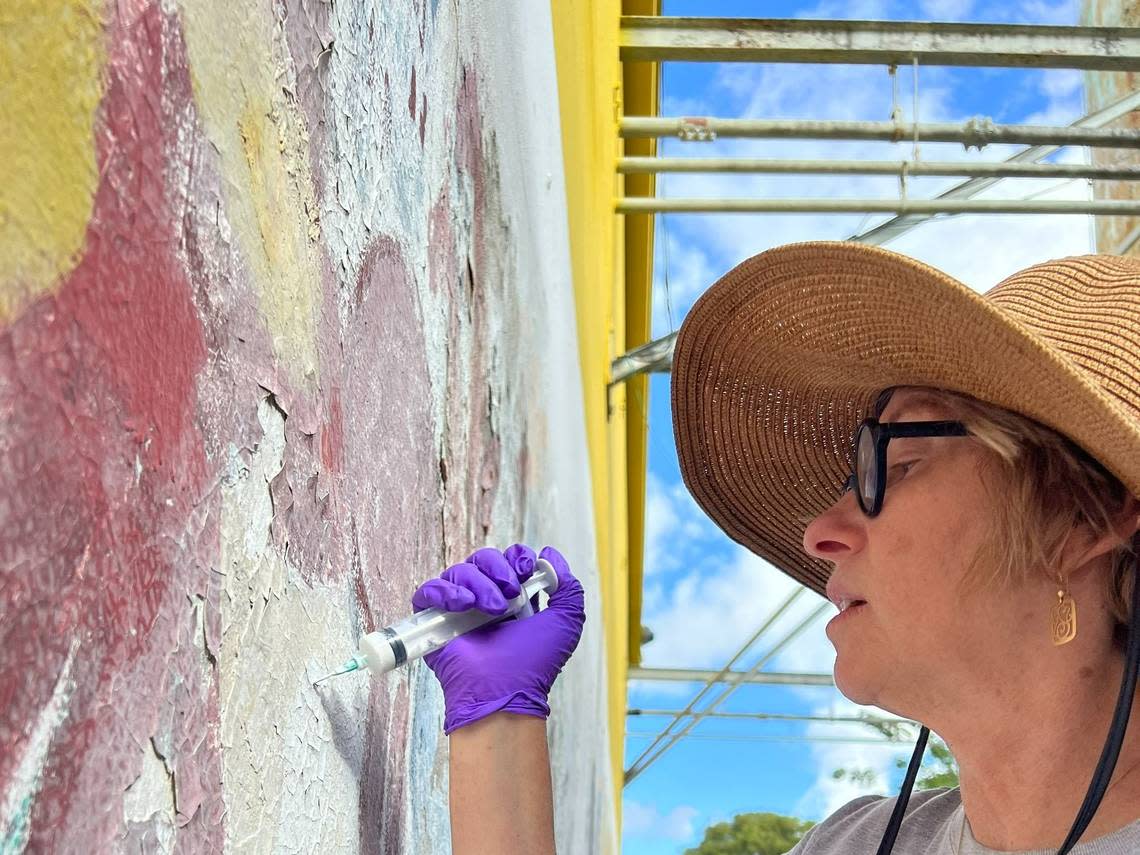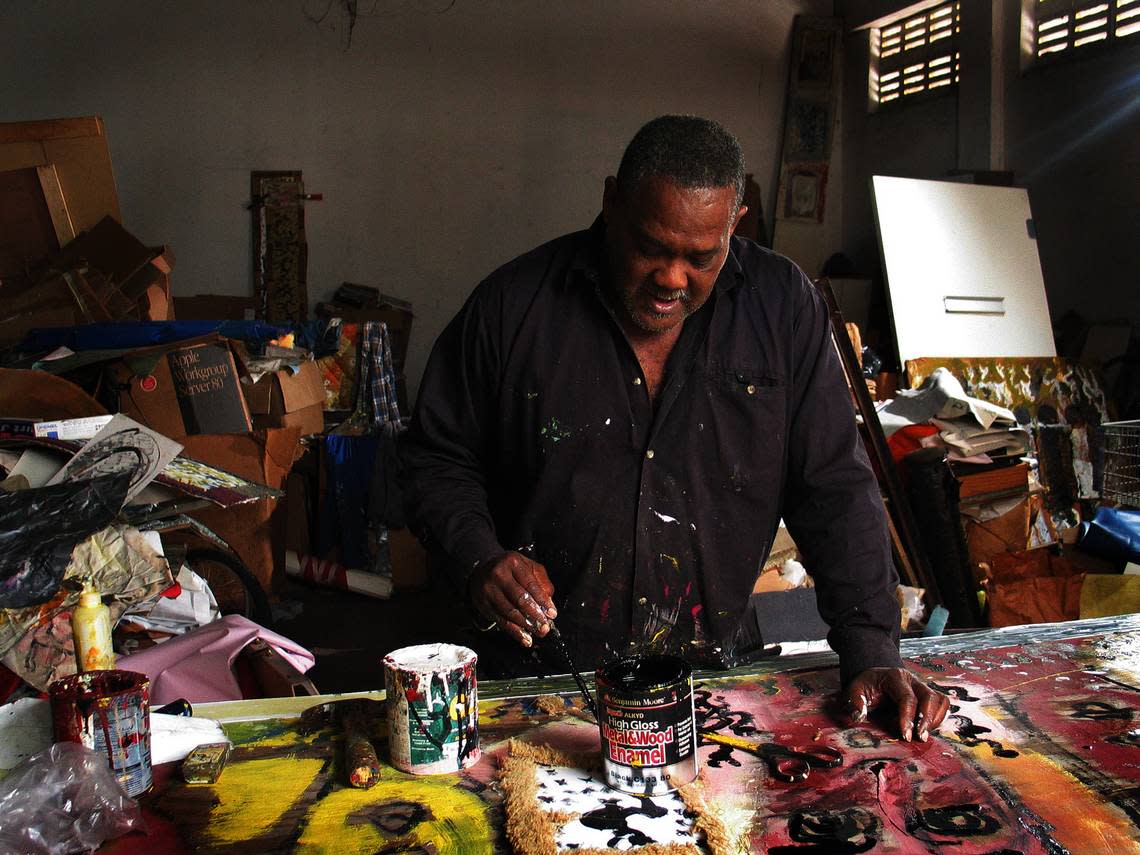This piece of Miami art history was falling apart. Meet the folks who saved it
Some worried it was too late.
On the east wall of Bakehouse Art Complex, a nonprofit collective of artist studios in Wynwood, is a mural by Purvis Young, a prolific and internationally recognized Miami artist who died in 2010. The once vibrant mural was cracked, chipped, faded and flaking off in pieces. The harsh sun had beaten down on it for years. Mold lived underneath the paint. Some parts of the mural were destroyed.
But with the help of an arts conservation grant, a skilled conservation team and months of painstaking work, Young’s mural -- one of the oldest in Wynwood -- has been revived. The newly preserved artwork will be unveiled to the public with a celebration on May 13.
This foundation wants to give local arts groups $3.5 million. Here’s how to apply
“The fact that we were able to bring what we thought was a lost work back to life is incredibly gratifying,” said Cathy Leff, the Bakehouse executive director. “It’s a relief. It’s a gift to the community. It’s a gift to us. It’s an incredibly proud accomplishment.”
The project was made possible with a donation from the Bank of America Art Conservation Project, a competitive grant program that provides international cultural institutions with funding to preserve and restore artworks in need of repair. Grantees include the Metropolitan Museum of Art, Notre-Dame de Paris and the British Museum.

The grant affirms the importance of Young’s legacy and his contributions to Miami’s cultural heritage, Leff said.
“We’re honored to have been recognized among such a distinguished group of international organizations as holding something so important,” Leff said. ”It should give Miami a lot of pride, Overtown in particular, having a piece of public art that was considered so worthy of being the recipient of this grant.”
Bakehouse used the funding to enlist RLA Conservation, a firm that conserves and restores artwork, historic buildings and artifacts. The team of conservators and artisans, based in Miami and Los Angeles, specializes in preserving work that faces harsh sunlight, salty air, humidity and tropical storms, said Rosa Lowinger, the RLA Conservation CEO and chief conservator.
The RLA Conservation team examined and tested the mural’s condition to see what could be done. The trickiest part was getting rid of the mold behind the paint without detaching the flakes, Lowinger said. The process was tedious, but Lowinger was not worried. The team of “art doctors” treated the mold, cleaned the dirt off the mural and re-adhered the flaking paint pieces one-by-one. The mural was “never dead,” Lowinger said. “It was just kind of on an oxygen tank.”

The artwork was not repainted, so pieces that were damaged remained lost. But the end result is a revitalized, preserved mural that is protected from the elements for future generations to enjoy.
“A really damaged patient can still be brought back to life,” Lowinger said. “I know when something is beyond and when something still has an opportunity.”
The conservation effort had more at stake than just making the mural beautiful again. The artwork at Bakehouse is one of just three surviving murals Young painted in Miami, according to Bakehouse’s grant proposal.
Young, an active artist who painted consistently, used inexpensive materials and found objects to create his works. Many of his artworks are ephemeral and struggle to stand the test of time. (In the ‘80s, Leff bought an artwork from Young made on paper and attached to wood. The work faded on its own over the years, making it practically white today, she said.)
Born in Liberty City in 1943, Young was a self-taught artist who earned notoriety for his paintings of Miami urban life, especially in the historically Black neighborhood of Overtown. In his late teens, he was convicted of a felony and sentenced to a couple of years in prison. While there, he spent his time drawing and reading art books, according to the New York Times.
In the 1970s, after his release, Young was inspired by protest art, like the Wall of Respect mural in Chicago. He started his own ambitious art project in an area known as Goodbread Alley, a part of Overtown known for once smelling like fresh baked bread. The expansion of I-95 in the ‘50s and ‘60s displaced many of those Overtown residents, leaving the buildings in Goodbread Alley abandoned. Young nailed large painted panels to the dilapidated buildings, garnering media coverage and jumpstarting his artistic career.
The buildings in Goodbread Alley, along with Young’s artwork, were eventually destroyed. By then, though, Young had made a name for himself, even though he wasn’t always appreciated in the local art scene. The Washington Post called him “perhaps the most famous painter to ever come out of Florida.”
“They was fixing to tear them down and build an expressway,” Young said in a 1995 interview. “I knowed when I was making the art that one day it was going to go. Nothing’s going to last forever.”
Kind of like the Bakehouse mural before it was cleaned, the details behind the making of the mural are a little fuzzy. Young painted it sometime between 1998 and 2002. He used normal house paint on a plain concrete wall to create the sprawling, colorful image of people, clouds, trees, horses and a cityscape reminiscent of Miami’s growing skyline.
Rosie Gordon-Wallace, a prominent Miami curator and friend of Young, knows the story. She made the mural happen.
It was 1998, and Young had gotten in trouble with the law at his warehouse for a nonviolent offense. Gordon-Wallace, who served on Bakehouse’s board, convinced the court to let Young do community service as part of his probation, according to the grant proposal. The court agreed, and Young completed his 100 hours of community service by painting the mural at Bakehouse.

Young always painted at night, so materials were left outside for him to use. When people arrived to Bakehouse the next morning, “we would see these images emerging,” Gordon-Wallace recalled. She said she is happy to see Young’s legacy and story preserved at Bakehouse.
“Purvis was a complicated, complex, amazing talent,” she said. “Brilliant man, but brilliant in different ways.”
The preservation of Young’s work is as important for Miami as it is for Bakehouse, Lowinger said. Miami is often billed as a “young” city. Regardless, Lowinger said, South Florida’s cultural heritage is worth preserving for the future, even if it’s only a few decades old.
“Here in South Florida, we have what we have,” she said. “You can’t get to 200 years with something if you’re not willing to preserve it after 30 years.”
Purvis Young mural conservation reveal
When: May 13, 11:30 a.m. to 1 p.m.
Where: Bakehouse Art Complex, 561 NW 32 Street, Miami
Info: Free and open to the public. Free street parking is available on 32nd Street and 6th Avenue and in the Jose de Diego Middle School parking lot across the street. https://www.bacfl.org/events/2023/5/13/purvis-young-mural-unveiling
This story was produced with financial support from The Pérez Family Foundation, in partnership with Journalism Funding Partners, as part of an independent journalism fellowship program. The Miami Herald maintains full editorial control of this work.
